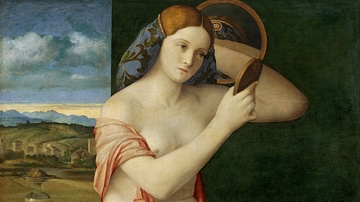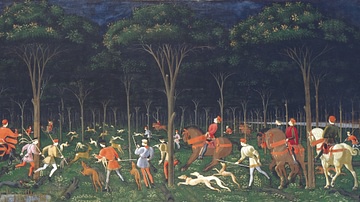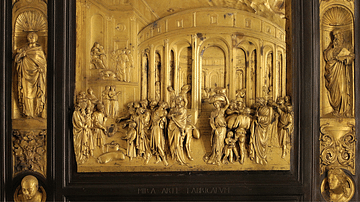There were three principal painting techniques during the Renaissance: fresco, tempera, and oils. In all of these techniques, colour was an important part of the painter's armoury, allowing them to create images that would strike a chord of recognition and pull a gasp of awe from the viewer. While many artists were skilled in all three techniques, as the Renaissance wore on, fresco was reserved for ceilings, tempera for small religious panels, and oils for wood panels or canvases, sometimes very large ones. Oils permitted much greater subtlety in execution and became the favoured medium of most late Renaissance masters, a preference that would continue in the following centuries.

Renaissance Colours
A wide range of colours was available to the Renaissance artist, but quality and brightness depended on the size of their purse, or perhaps more accurately, that of their patron. Colours were made from earths and minerals. Lakes were colours made from organic material like plants, flowers, and berries and were relatively cheap and easy to acquire. Metal and mineral-based pigments were more expensive. Lead was used to make white and red, tin or orpiment for yellow, azurite for blue, and malachite for green. An artist or his supplier might have to visit a port like Antwerp, Bruges, or Venice, which had trading links across the Mediterranean and Asia, in order to acquire the rarer and very best pigments. The only source for ultramarine, for example, was lapis lazuli from Afghanistan. For this reason, commission contracts often specified limits on certain materials so that the finished work of art remained within the means of the patron.
Pigments were available from merchants, apothecaries, and monasteries. Prices also varied depending on the grade and colouring of the raw material but we have many artist's account books to determine what cost what, where, and when. To compare colours and materials, 28 g (1 oz) of ultramarine (then sometimes called azur of Acre) cost four francs in Dijon in 1389 CE, enough to buy 3.6 kg (8 lbs) of vermillion, 7.2 kg (16 lbs) of lead white or 300 sheets of very fine gold leaf. It is perhaps understandable, then, that many artists, instead of ultramarine, used azurite, which was ten times cheaper (but less intense). Very deep or intense reds were another expensive addition to an artist's palette. These were made from the crushed scales of insects like the kermes beetle. Again, a much cheaper but less colourful alternative was available, this time ground madder root.
It is not perhaps surprising that these expensive commodities were one of the major assets of a workshop. Indeed, artists often left their pigments to relatives in their wills. Many artist guilds insisted, too, that certain pigments not be used in certain media. This ensured a distinction of high quality in panels, for example, and meant that a copyist could not pass off a painted piece of cloth as equal in value to a panel; the two would not have had the same colouring. In addition, this also reserved certain of the best materials for those artworks intended for a higher purpose such as altarpieces and other artworks destined for churches.

Once acquired, pigments were ground on a stone slab - preferably something non-porous like marble - using a cone-shaped stone known as a muller. Producing a fine powder was a laborious task, but it was not without some skill. Too little or too much grinding of certain pigments did not achieve their optimum colouring. Then mixing pigments with the correct amount of liquid medium to achieve the luminosity and texture an artist required was another task that required experience. Both written records and paintings of workshop scenes attest that paint preparers were specialised members of a workshop and not, as is often claimed, young apprentices.
The use of bright colours became especially popular in Venice where the technique of colore (aka colorito) was popular, that is using the juxtaposition of colours to define a composition rather than lines. Titian (c. 1487-1576 CE) and Tintoretto (c. 1518-1594 CE) were famous exponents of this technique. However, some artists and, presumably, therefore, clients, preferred more subdued colouring for certain subjects, for example a painting showing the death of Jesus Christ or a saint.
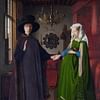


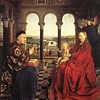
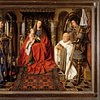

A Gallery of 50 Renaissance Paintings
Jean Lemaire de Belges wrote the following verse in his La Couronne Margaritique (c. 1505 CE), a description of the typical paraphernalia in an artist's workshop:
Their studio is full of panels
Some painted, some to be painted, and many noble tools.
There are charcoals, crayons, pens, fine brushes
Bristle brushes, piles of shells
Silverpoint, which makes many subtle marks
Polished marbles, as brilliant as beryl.
(Nash, 157)
The polished marbles are surely the stained marble slabs used to grind the pigments. The shells described above, typically mussel and oyster shells, were used to keep the ground powder in until needed by the artist. Brushes were either made by the artist or bought readymade in various sizes. There were two categories of hair brushes: pig/hog or squirrel/fox. Size varied depending on the task but ranged from fine points of a few millimetres to broad brushes of three centimetres (1.2 in).

Finally, gold, silver, and tin leaf were used in pieces made for wealthy clients or important churches. Later Renaissance oil painters were able to reproduce metallic effects using oils but precious materials were, in any case, sometimes required for prestige pieces. The base panel was prepared with a smooth layer of ground chalk and then a layer of greasy brown clay over which superthin pieces of beaten gold, silver, or tin were applied. The preparatory surface dried very quickly and so to add metal leaf to a piece and not have any bubbles or wrinkles at the end was a task for someone with great experience and a very steady hand. Leaf could then be polished using a tooth or small smooth stone. Sometimes leaf work was punched to create patterns or painted and then areas scraped away to reveal the metal beneath, again to make patterns.
Fresco
The fresco technique has been used by artists ever since antiquity, and it continued during the Renaissance to be the most popular method of painting larger surfaces like interior walls in churches, public buildings, and private homes. However, as oil paintings on large canvases became more popular through the 16th century CE, so frescoes were often limited to the upper parts of walls and ceilings.
True fresco (aka buon fresco) involved first covering the wall area with a layer of wet plaster (arriccio) which has a consistency coarse enough to act as a binding agent for a second, finer layer of plaster (intonaco). The approximate design was then drawn onto the plaster, either using a material like charcoal or by placing over the wall a large paper sketch (a 'cartoon') with holes punched in it and then blowing charcoal dust through the holes (pouncing). Charcoal was a useful material as it could easily be rubbed out using a finger or a piece of soft bread. Alternatively, the outline of the cartoon could be scored onto the plaster using a stylus.

Next, the artist decided which part of the wall he was going to work on that particular day - typically they worked from the top of the wall downwards - and covered it with a very thin layer of fresh plaster, translucent enough to see the design behind it or by redoing that section of drawing using charcoal. The artist was then in a race against time before the plaster dried out, usually one working day. As a consequence of this process, art historians are able to identify the sequence that pieces of wall were painted and approximately how many days they took to paint.
Water-based coloured pigments were then used to paint the final pictures. The colours and plaster dried together, fixing themselves to each other and making it possible for a fresco to last for centuries. This is due to the chemical process where the drying plaster creates a coating of carbonate of lime crystals. It is these crystals which coat the paint, not only protecting it but making the colours brighter, too, as the surface dries. For this reason, an artist had to paint using darker tones than really required. Finally, fine details or corrections might then be added using 'dry' paints (fresco secco). A supreme example of success using fresco is the Sistine Chapel ceiling by Michelangelo (1475-1564 CE), completed in 1512 CE.
Some artists did try and experiment with this tried-and-tested technique but not with very much success. The problems with fresco were the necessity to work fast, the need to scrape off an area and start from scratch if a mistake was made, and the lack of opportunity to blend colours like one could in oil painting. Another disadvantage was that frescoes tended to deteriorate badly in damp climates. The most infamous instance of an artist using only 'dry' paints on a fresco is The Last Supper which Leonardo da Vinci (1452-1519 CE) painted in Milan (a city with high humidity) but which began to crumble away within decades of its completion c. 1498 CE.
Tempera
Tempera is a painting technique which dates back to antiquity when it was especially used by artists in ancient Egypt. It involves mixing colours in fine powder form with a liquid that acts as a binding agent, most commonly egg yolk mixed with water (egg white can discolour, while yolk loses its colour). An alternative was to add oil to the solution which makes it dry faster and permits application to softer surfaces like canvas. A third recipe used white curd instead of egg yolk and added diluted lime juice to the mix.
The advantage of creating the colours in this way is that they become much brighter and have a translucent quality useful for building up layers of colour in order to give an image depth and texture. A disadvantage was that colours could not be mixed when applied to the working surface. Consequently, an artist usually applied the darkest shade of a colour first and then added successive layers or areas of lighter shades.

Tempera was most commonly applied to gesso or wooden panels. The wood used was mostly pine or poplar in southern Europe and Baltic oak in northern Europe. Wood panels were typically made by a specialist and then bought by the painter; the same was true for picture frames. The wood was first covered with a layer of thin linen and then a chalk and glue mixture. As with fresco, the artist might create a rough sketch on the panel, then cover this with a smooth translucent layer of mostly oil, and then fill in the design using tempera colours. The Flagellation of Christ by Piero della Francesca (c. 1420-1492 CE), created c. 1455 CE, is an example of tempera on panel painting, although Piero was something of an experimenter and sometimes mixed tempera colours with oil colours.
Oil Painting
Oil paints were made from powdered pigments added to oil, most often linseed oil, but sometimes others like walnut oil, which was especially good at making white more luminous. Some artists heated the oil before use as this made the paint less likely to shrink and crack when it dried.
The Netherlandish artist Jan van Eyck (c. 1390-1441 CE) was traditionally credited with inventing the oil painting technique but it was, in fact, a much older method that had simply fallen out of favour with artists. Van Eyck was given this honour probably because he was the undoubted master of oil painting and he was one of the first Renaissance artists to regularly use oil paints in his work. By the end of the 15th century CE, most major Renaissance artists in the Low Countries and Italy, especially, used oil paints when working at an easel, not tempera.

Oil paints were versatile and could be applied to prepared wooden panels, canvas, paper, fabric, or a wall surface. A primer layer of white or very light grey was typically applied to the surface before painting began proper. Then various layers were applied with the artist usually starting with the background, then peripheral elements, next clothing and draperies, and finally hands and faces. The rich colours oil paints offered were ideally suited for the brocaded clothing, plush drapery, and sparkling jewels that were fashionable at the time. Such were the possibilities of oils that, as mentioned above, even metallic materials made with gold and silver could be rendered without the need for gold and silver leaf.
Oils allowed for a much greater subtlety in colours because translucent colours can be variously layered or coloured areas can be composed of layers of varying thickness of paint, thus creating a very wide range of colour tones. Analysis of Renaissance paintings has revealed that there are often up to seven different layers of paint in any one area. Further, brush strokes using oils can become invisible or they can be used for effect, the artist deliberately varying their size, shape, and direction. A consequence of this layering and variation in brushwork was the achievement of real depth in a painting that tempera panels or frescoed walls could not match. So, too, details like skin texture, hair, and wrinkles, as well as optical effects like reflections, could now be represented as never before. Another great advantage is that oils can take several days to dry out and this allows the artist to mix, blend, adjust or completely rework an area of his painting (even using their fingers to do so). Further, any mistakes can be covered over with extra layers of paint once the original layers have dried. No wonder, then, that oil painting is still the first choice of fine artists today. Once finished, a Renaissance oil painting was usually given a thin layer of protective varnish to ensure the work lasted far beyond the lifetime of its creator.



